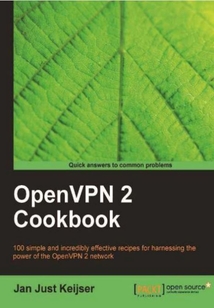舉報(bào) 

會(huì)員
OpenVPN 2 Cookbook
最新章節(jié):
Index
Thisisacookbook,withpracticalrecipesprovidingtipsandtrickstothemostcommonproblemsandscenariosfacedwithOpenVPN.ThisbookisidealforsystemadministratorsandnetworkingprofessionalswhoareinterestedinbuildingsecureVPNsusingOpenVPN.ItispreferablethatthereaderhasabasicknowledgeofOpenVPN,aswellasgeneralnetworkadministrationskills.
目錄(126章)
倒序
- 封面
- 版權(quán)頁
- Credits
- About the Author
- About the Reviewers
- Support files eBooks discount offers and more
- Preface
- What you need for this book
- Who this book is for
- Conventions
- Reader feedback
- Customer support
- Chapter 1. Point-to-Point Networks
- Shortest setup possible
- OpenVPN secret keys
- Multiple secret keys
- Plaintext tunnel
- Routing
- Configuration files versus the command-line
- Complete site-to-site setup
- 3-way routing
- Chapter 2. Client-server IP-only Networks
- Setting up the public and private keys
- Simple configuration
- Server-side routing
- Using 'client-config-dir' files
- Routing: subnets on both sides
- Redirecting the default gateway
- Using an 'ifconfig-pool' block
- Using the status file
- Management interface
- Proxy-arp
- Chapter 3. Client-server Ethernet-style Networks
- Simple configuration—non-bridged
- Enabling client-to-client traffic
- Bridging—Linux
- Bridging—Windows
- Checking broadcast and non-IP traffic
- External DHCP server
- Using the status file
- Management interface
- Chapter 4. PKI Certificates and OpenSSL
- Certificate generation
- xCA: a GUI for managing a PKI (Part 1)
- xCA : a GUI for managing a PKI (Part 2)
- OpenSSL tricks: x509 pkcs12 verify output
- Revoking certificates
- The use of CRLs
- Checking expired/revoked certificates
- Intermediary CAs
- Multiple CAs: stacking using --capath
- Chapter 5. Two-factor Authentication with PKCS#11
- Initializing a hardware token
- Getting a hardware token ID
- Using a hardware token
- Using the management interface to list PKCS#11 certificates
- Selecting a PKCS#11 certificate using the management interface
- Generating a key on the hardware token
- Private method for getting a PKCS#11 certificate
- Pin caching example
- Chapter 6. Scripting and Plugins
- Using a client-side up/down script
- Windows login greeter
- Using client-connect/client-disconnect scripts
- Using a 'learn-address' script
- Using a 'tls-verify' script
- Using an 'auth-user-pass-verify' script
- Script order
- Script security and logging
- Using the 'down-root' plugin
- Using the PAM authentication plugin
- Chapter 7. Troubleshooting OpenVPN: Configurations
- Cipher mismatches
- TUN versus TAP mismatches
- Compression mismatches
- Key mismatches
- Troubleshooting MTU and tun-mtu issues
- Troubleshooting network connectivity
- Troubleshooting 'client-config-dir' issues
- How to read the OpenVPN log files
- Chapter 8. Troubleshooting OpenVPN: Routing
- The missing return route
- Missing return routes when 'iroute' is used
- All clients function except the OpenVPN endpoints
- Source routing
- Routing and permissions on Windows
- Troubleshooting client-to-client traffic routing
- Understanding the 'MULTI: bad source' warnings
- Failure when redirecting the default gateway
- Chapter 9. Performance Tuning
- Optimizing performance using 'ping'
- Optimizing performance using 'iperf'
- OpenSSL cipher speed
- Compression tests
- Traffic shaping
- Tuning UDP-based connections
- Tuning TCP-based connections
- Analyzing performance using tcpdump
- Chapter 10. OS Integration
- Linux: using NetworkManager
- Linux: using 'pull-resolv-conf'
- MacOS: using Tunnelblick
- Windows Vista/7: elevated privileges
- Windows: using the CryptoAPI store
- Windows: updating the DNS cache
- Windows: running OpenVPN as a service
- Windows: public versus private network adapters
- Windows: routing methods
- Chapter 11. Advanced Configuration
- Including configuration files in config files
- Multiple remotes and remote-random
- Details of ifconfig-pool-persist
- Connecting using a SOCKS proxy
- Connecting via an HTTP proxy
- Connecting via an HTTP proxy with authentication
- Using dyndns
- IP-less setups (ifconfig-noexec)
- Chapter 12. New Features of OpenVPN 2.1 and 2.2
- Inline certificates
- Connection blocks
- Port sharing with an HTTPS server
- Routing features: redirect-private allow-pull-fqdn
- Handing out the public IPs
- OCSP support
- New for 2.2: the 'x509_user_name' parameter
- Index 更新時(shí)間:2021-04-09 22:06:17
推薦閱讀
- UG NX10.0從新手到高手
- 中文版Illustrator CC實(shí)用教程
- 穿越Photoshop CC
- 中文版 Photoshop CC 從入門到精通
- 我為PS狂 Photoshop照片處理一分鐘秘笈
- Windows Phone 7 Silverlight Cookbook
- 中文版Photoshop CS6從新手到高手·全彩版
- 用Multisim玩轉(zhuǎn)電路仿真
- MATLAB R2024a完全自學(xué)一本通
- Magento: Beginner's Guide
- Photoshop-CorelDRAW 基礎(chǔ)培訓(xùn)教程
- 老郵差 Photoshop數(shù)碼照片處理技法 圖層篇(修訂版)
- Magento 1.4 Development Cookbook
- UG NX 12.0完全自學(xué)手冊(cè)(第4版)
- 中文版Photoshop CS6經(jīng)典自學(xué)教程(培訓(xùn)教材版)
- AutoCAD快速自學(xué)寶典(2019中文版)
- After Effects CC入門與應(yīng)用
- Moodle 1.9 Teaching Techniques
- Moodle Security
- AutoCAD 2012建筑設(shè)計(jì)與制作標(biāo)準(zhǔn)實(shí)訓(xùn)教程
- UG NX11.0中文版從入門到精通
- 用Logic Pro輕松制作你的短視頻音樂
- Moodle 1.9: English Teacher's Cookbook
- Getting Started with DraftSight
- iPad數(shù)字繪畫創(chuàng)作全攻
- Corel Painter 11插畫設(shè)計(jì)與繪制標(biāo)準(zhǔn)實(shí)訓(xùn)教程
- SolidWorks快速入門教程(2019版)
- Photoshop CC 2019從新手到高手
- Photoshop 2020中文版從入門到精通
- Hacking Vim 7.2

